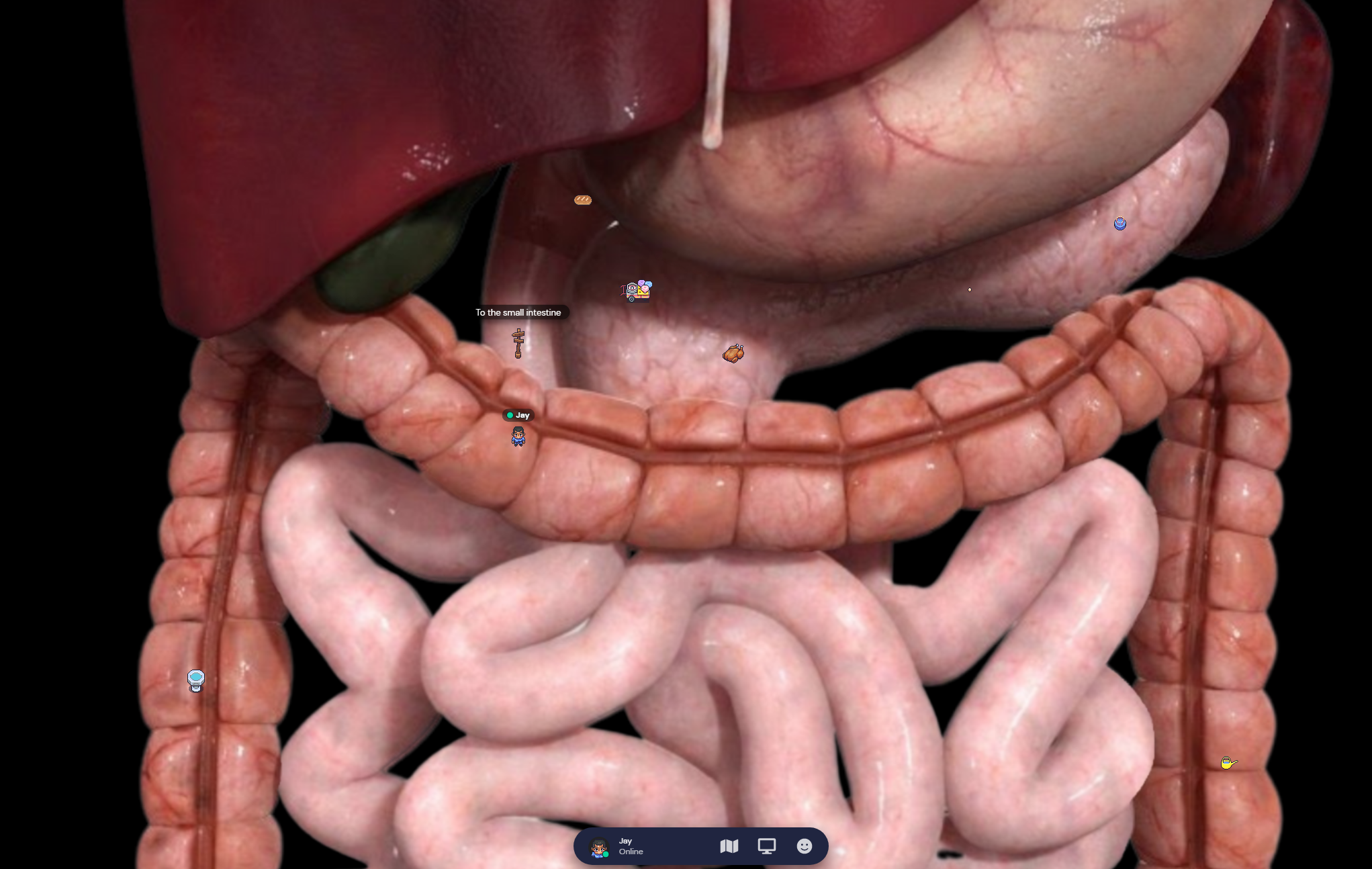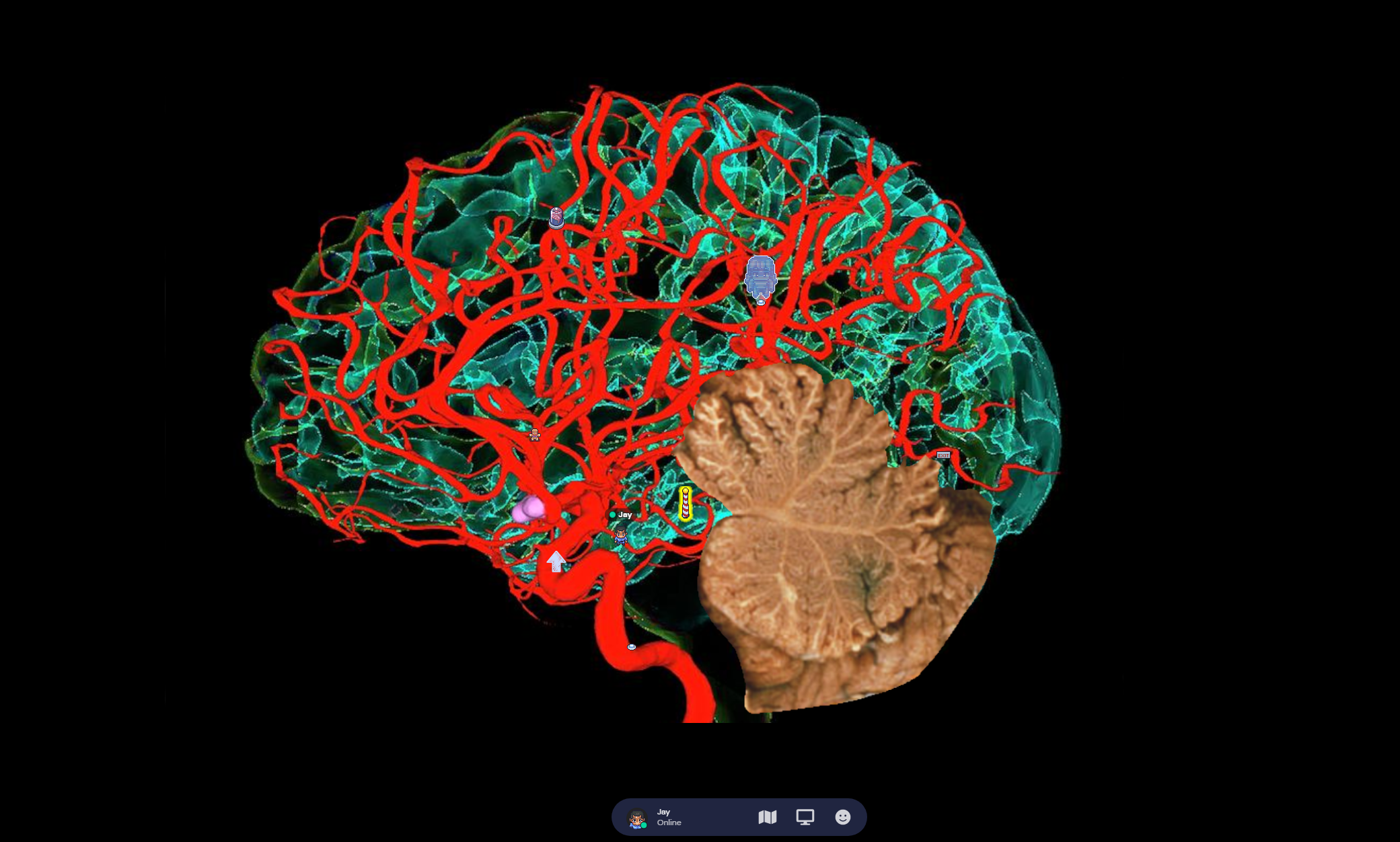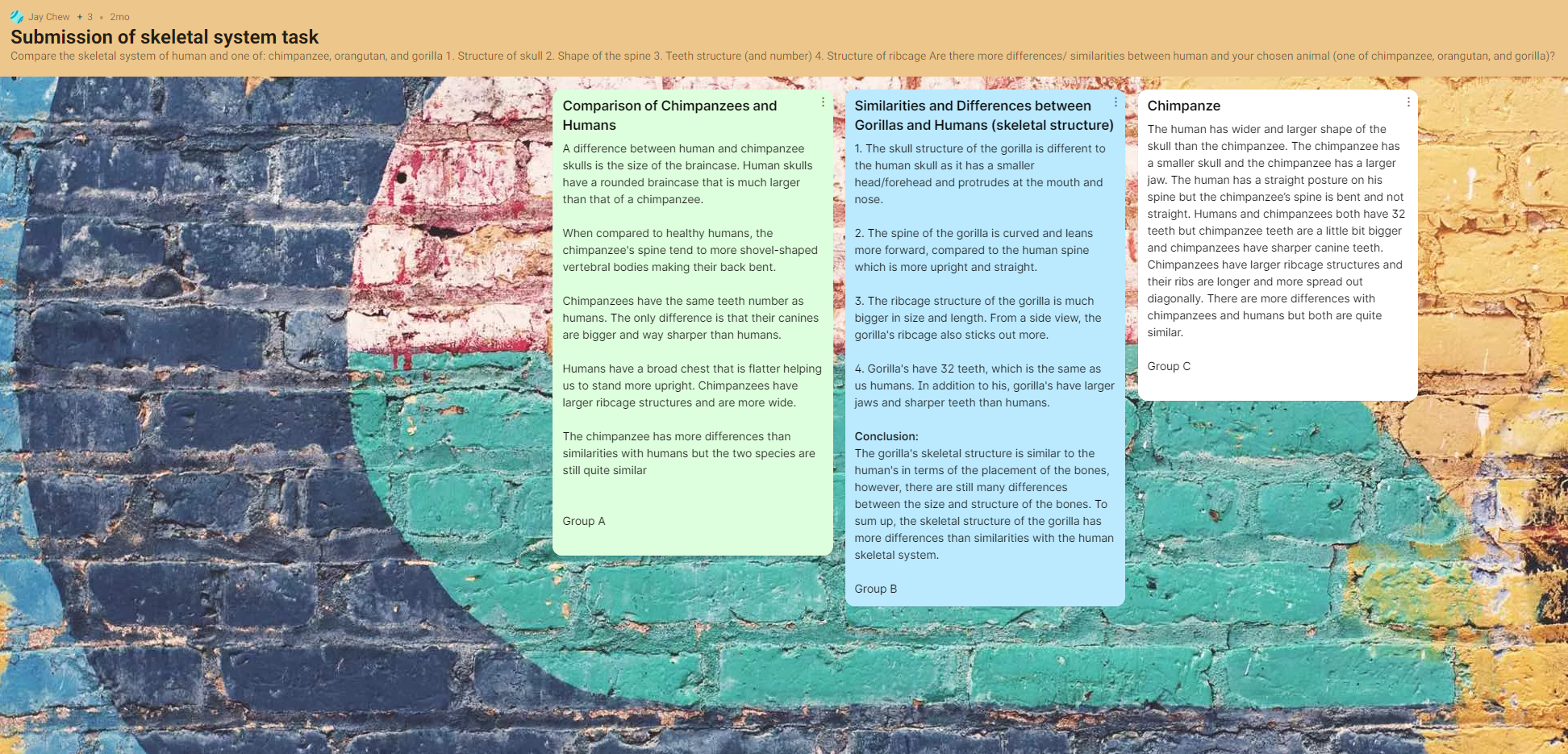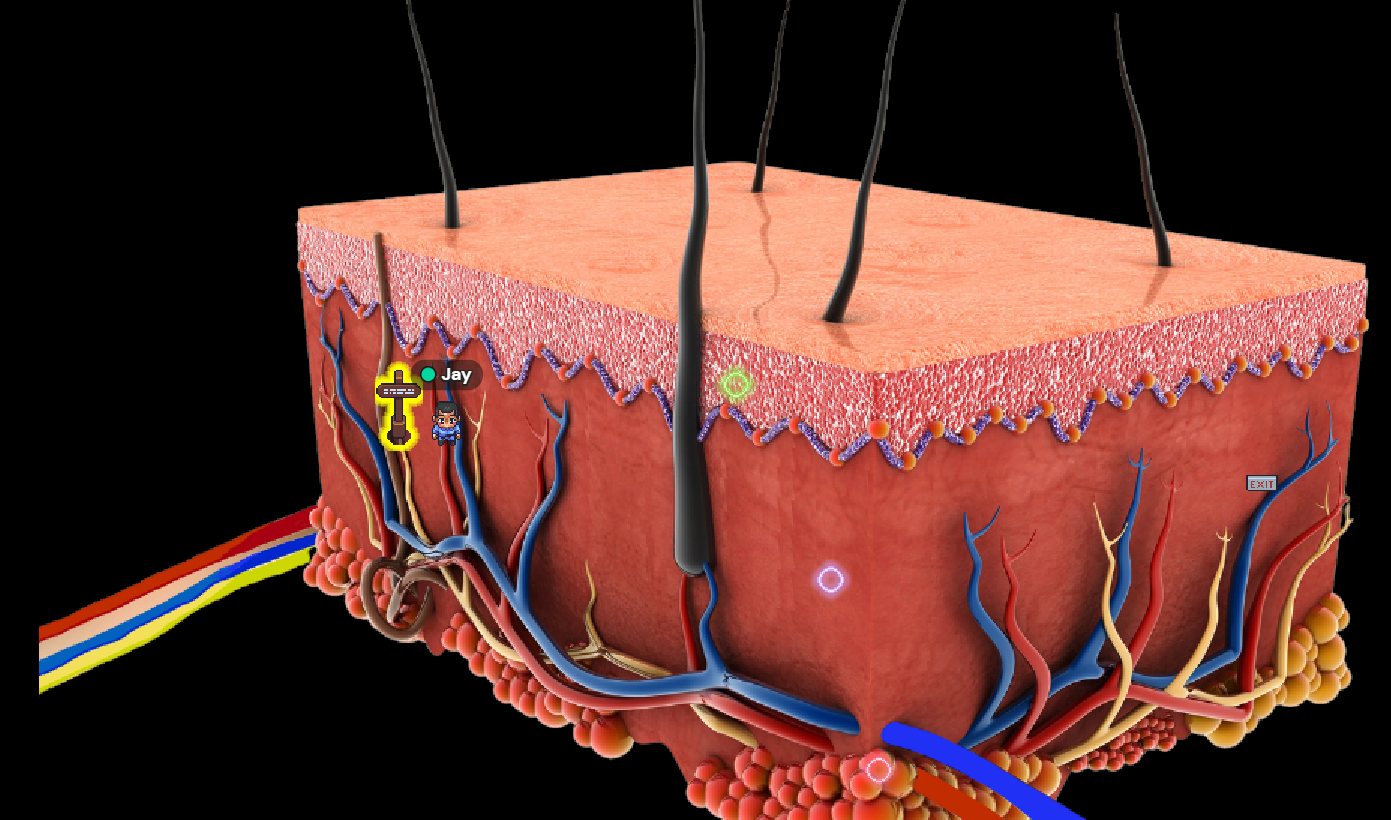As a k20 Educators Virtual World Think Tank fellow in 2022, I used Gathertown, a virtual world building platform to teach my Year 8 Science students (15 students in total) about the concept of anatomy in the science classroom over a two-month period. In each lesson, students venture around the customed-built Gathertown maps that focus on the brain anatomy, skeletal system, digestive system, and the human skin (Gather, 2022). These concepts are covered in the Years 8 and 9 Australian Curriculum. Based on the curriculum, students need to explain how different body systems work together to maintain a functioning body using models, flow diagrams or simulations. Gathertown maps provide us with a platform to create models of these anatomy maps, as well as navigating through existing 3D anatomy models from HologoWorld (Hologo - Creating extraordinary human beings, 2022).
All of the lessons below were delivered by me using the Gather virtual worlds that I built. Gather is a video chat platform designed to make virtual interactions more human. It is free to build and use Gather spaces for up to 25 people at once. The k20 Educators Think Tank gave 7 educators the chance to collaborate on virtual world building from November ’21 to March ’22.
In my first lesson, students walk into a digestive system model, where they assume the role of food that is entering a person’s body through the mouth (Figure 1). Each food path consists of an activity or a challenge that students need to complete. Upon arriving at the small intestine, students need to escape a maze before heading to the large intestine. At the end of the session, students work in groups of 4-5 to complete a Mentimeter activity by listing down a research question, aim and hypothesis for the experimental design on the digestive system.

“My most favourite map was the digestive system because it was the most interactive, I find Gather town quite interesting since you can like interact with other people. And it's kind of like Zoom because, you can see the faces and actually talk to them.”- Anonymous student
Building the digestive system as a virtual world meant that I could get students to move around in a space that would otherwise not possible through diagrams or PowerPoint slides in the classroom. In addition, students can complete the tasks based on their learning abilities, and at their own pace. As the Gather learning space is available 24/7, students can log onto the platform from any location and any time. This flexibility enables me to provide my students with the responsibility of managing their time spent on the platform, as long as they complete their tasks by the due dates.
The next lesson involves students navigating through the human brain, which include the cerebrum, cerebellum, and the brain stem (Figure 2). By understanding the different components of the brain, students investigate a neurodiverse condition by either explaining how people live with a particular neurodiverse condition, breaking down stereotypes that exist around people with neurodiversity or exploring ways in which neurodiverse people can be supported by the wider community. They then present their findings to the class in groups of 3-4.

“I enjoyed the brain anatomy the most. I generally enjoy learning about the brain and when that passion was put into an interactive platform, it enhanced.”- Anonymous student
In the subsequent two weeks, students investigate the human skeletal system and the layers of human skin on Gathertown. Firstly, students navigate through different sections of the human skull and skeleton. They then observed the X-ray and CT scan images of human nose and teeth. Through Padlet, students discuss in groups of 3-4 to compare the skeletal system of humans with other hominids, such as chimpanzee, orangutan, and gorilla (Figure 3). The comparison includes the structure of skull, the shape of the spine, the teeth structure as well as the structure of the ribcage.

“The skeletal map interested me the most because of the different elements and components that were scattered around the map.”- Anonymous student
While moving across layers of the human skin, students identify the differences between the epidermis, dermis, and subcutaneous layers (Figure 4). They have then used Telegram to unravel riddles and to answer questions in relation to the human skin, which include the function of the epidermis, the location of the sweat glands and the components of the dermis layer. We have encountered difficulties with the Telegram bot at the initial stage, whereby students are not getting responses on the platform after keying their inputs to the questions. However, the issue with the bot has later being rectified. Overall, I have discovered that students enjoy learning through the Telegram bot, instead of the traditional teacher-talk on the concept.

Upon completion of the activities on Gathertown, students complete written survey and verbal interview on their virtual world experience. 83% of the students have reported positively on learning through virtual worlds in the classroom. From the positive feedback and comments, two main themes are being repeated: the features of Gathertown, and the students’ interactions on the platform.
A selection of the positive quotes from the surveyed students:
- In Gather, it's sort of like Zoom, we put the cameras and like, we can have audio, but it's more exciting because like, you can move around, you can explore the place. (Features of Gathertown)
- I think Gather is an engaging platform. So, I think it engages a lot of students and kind of motivates them to focus and participate in class. It brings a new perspective on learning and I think it's a bit more interesting. (Students’ interactions on the platform)
- I find Gather pretty good, especially like when you have separate places, it's like breakout rooms in Zoom, but it's like in one place. So, you can discuss between people like in class. (Students’ interactions on the platform)
- I think Gathertown is effective because it helps me learn by letting us interact with the class and lesson. Playing games in the map helps me a lot to remember their uses and what it looks like. (Students’ interactions on the platform)
On the other hand, students have reported their concerns of being distracted on the platform. They have then provided suggestions on ways that can be implemented to enhance learners’ experience in virtual world. Two main themes are being repeated: using Gathertown as a recap tool and to have a balance between the use of virtual world and in-class activities.
The suggestions from the surveyed students:
- We could use Gathertown at the end of each classroom lesson as a sense of reflection and self-correcting. (Gathertown as a recap tool)
- Gather could be a fortnightly thing like doing it occasionally, it could be fun because sometimes it can be engaging, but a classroom can be whatever it wants to be and Gather can create a lot more, a lot more topics and more discussions. (Balance between the use of virtual world and hands-on activities)
To address students’ concerns on the use of virtual worlds in the classroom, we will now use Gathertown and other virtual reality/ augmented reality apps once a fortnight as a summative tool to recap on students’ learning in the classroom. On top of that, we are incorporating quizzes, crossword puzzles and other hands-on activities onto the virtual world, to continue our quest of creating more presence and interactions in the classroom.
Overall, the Gathertown platform has allowed me to change the way I teach in the classroom, and on the tools that I can use to engage my students using virtual world. If you like to try this out with your class, I would recommend that you set your learning goals on what you would want to achieve, then run through your customised maps with other teachers in your department. Once you have sort out any issues with the maps, then you are ready to use them with your students!
References
App.gather.town. 2022. Gather. [online] Available at: https://app.gather.town/app [Accessed 7 April 2022].
Hologo.world. 2022. Hologo - Creating extraordinary human beings. [online] Available at: https://hologo.world/ [Accessed 7 April 2022].